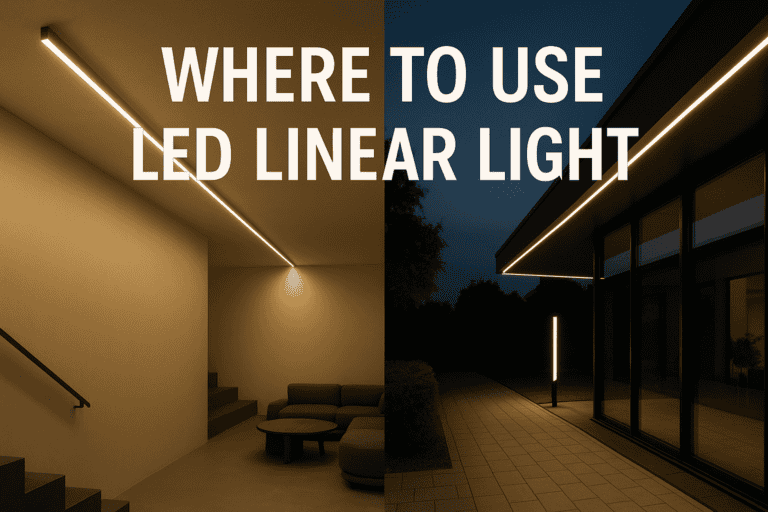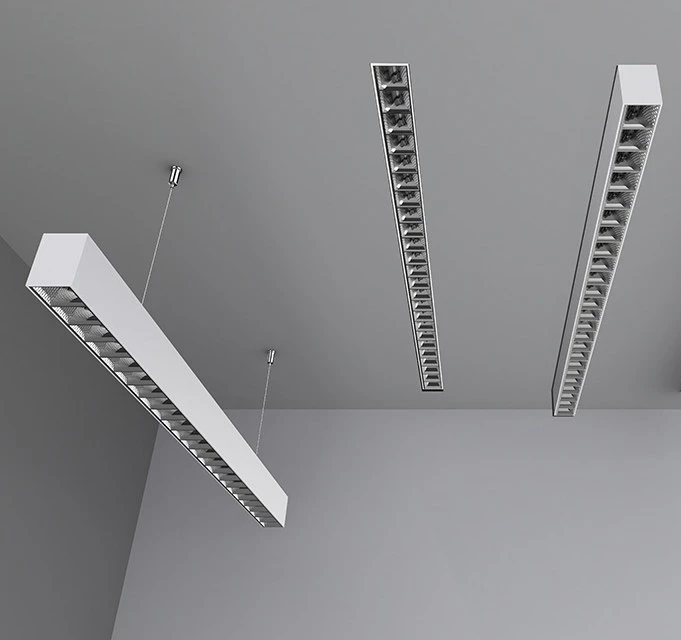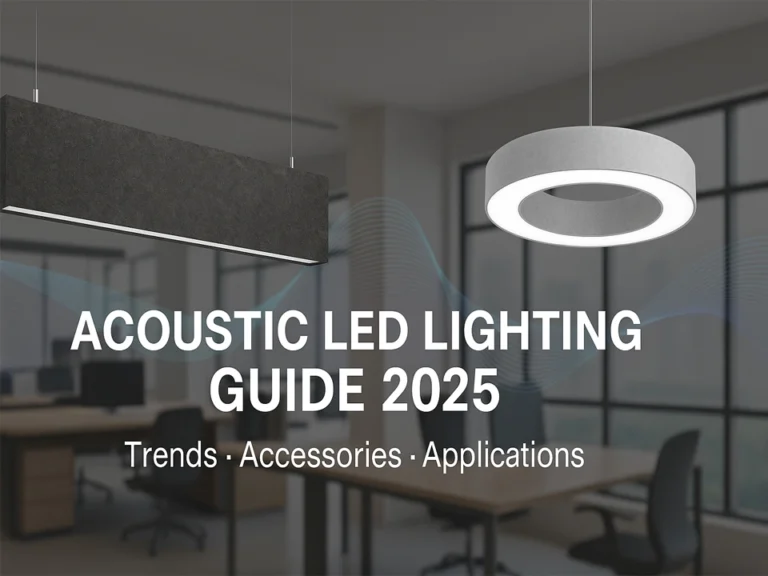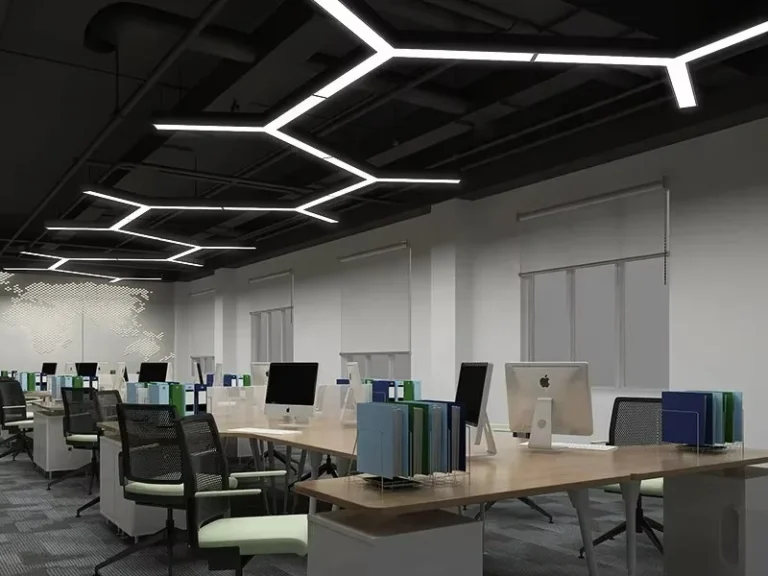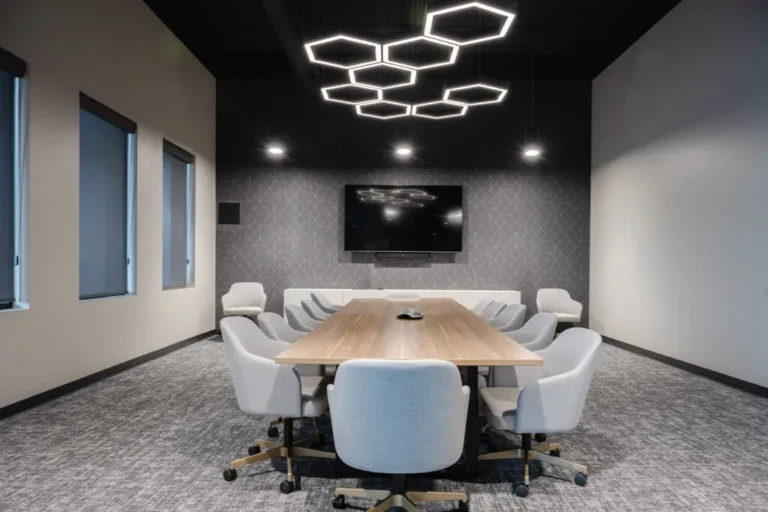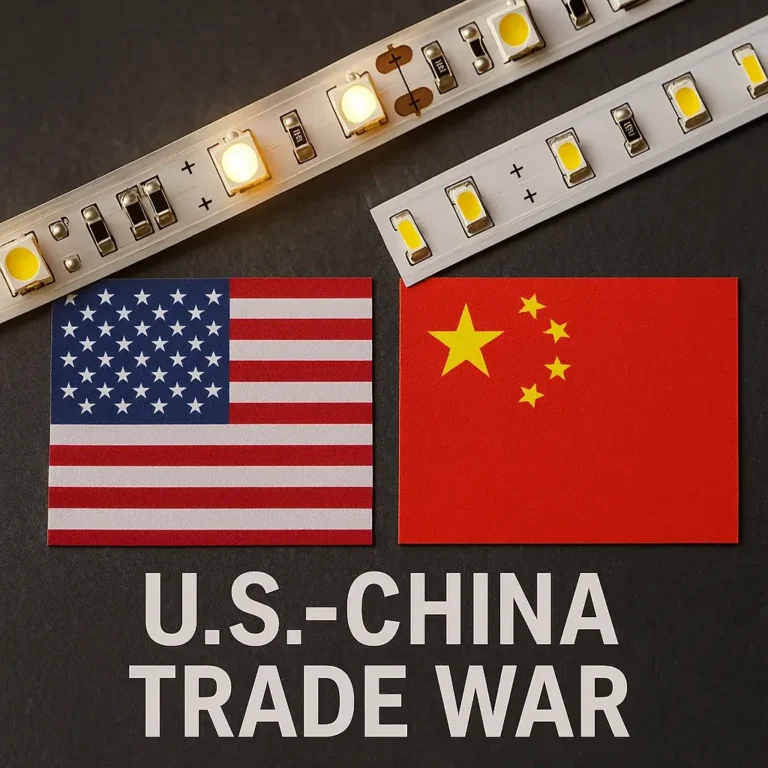2025 yılında akıllı ofisler dalgasında, LED doğrusal ışıklar, temel aydınlatma araçlarından üretkenliği ve mekansal estetiği artıran çift taşıyıcılara dönüşmüştür. Doğal ışık spektrumlarını 4000K-5000K renk sıcaklığı ile simüle ederek ve UGR<19 parlama azaltma tasarımını ekleyerek, 42% ile görsel yorgunluğu azaltırlar (CIE 2024 raporuna göre), dijital çağdaki ofis çalışanları için göz yorgunluğunu etkili bir şekilde hafifletir.
LED doğrusal ışıklar, modüler tasarım sayesinde ofis alanlarında kesintisiz aydınlatma sağlar ve geleneksel aydınlatma armatürlerinin enerjisinin sadece 40%'sini tüketir. Akıllı bir karartma sistemi ile eşleştirildiğinde, doğal ışık değişikliklerine dinamik olarak uyum sağlayabilirler. Gizli kurulum süreci, ofislere işlevsellik ve estetik değeri birleştiren bir aydınlatma çözümü sağlayarak, akıllı ofis ortamlarında standart bir unsur haline getirerek tavan yapılarını basitleştirir.
LED doğrusal aydınlatma özellikleri ve teknolojisi
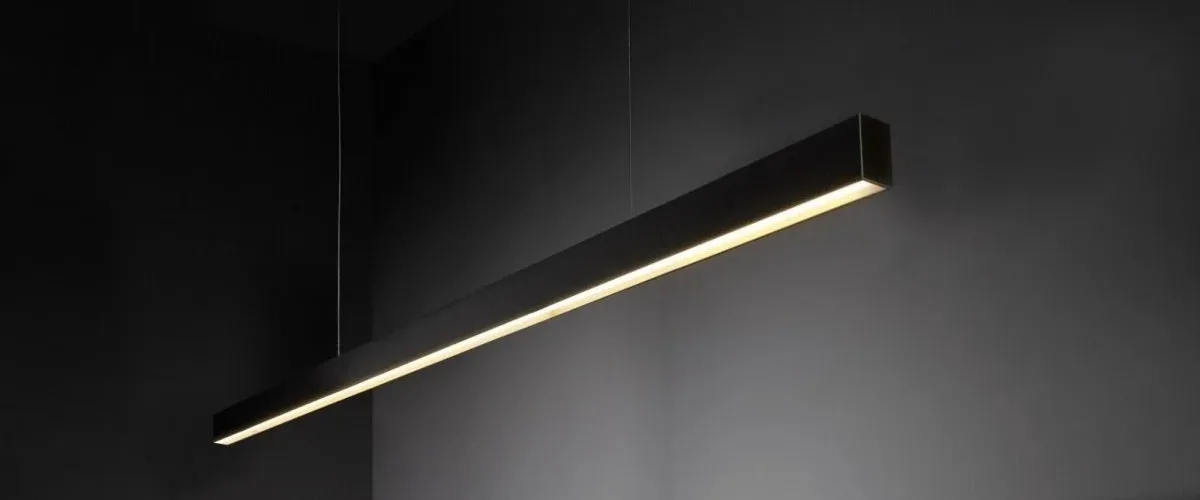
gelişimi LED lineer aydınlatma Performansı, verimliliği ve tasarımı artıran birçok gelişmiş özellik ve teknolojiyi tanıttı. Aşağıdakiler bazı önemli yenilikler:
Aydınlatma tekdüzeliği: Derin (≥1,2 cm) çerçeve ışık yuvası ile birlikte COB paketleme teknolojisinin (metre başına 360 LED çipi) kullanılması, grenliliği ortadan kaldırır ve kesintisiz, sürekli ışık çıkışı sağlar.
Enerji verimliliği ve uzun ömür: Sabit akımlı sürücü ile birleştirilen düşük voltajlı güç kaynağı (24V), 50.000 saati aşan bir kullanım ömrü ile istikrarlı akım ve titremesiz çalışma sağlar. Işık sensörleri, talebe dayalı dinamik parlaklık ayarı sağlayarak 45%'ye kadar enerji tasarrufu sağlar.
Kablosuz bağlantı ve akıllı kontrol: Birçok LED lineer ışık, aydınlatma ve renk sıcaklığı kontrol fonksiyonları sunar, aydınlatmayı farklı ruh hallerine ve görevlere uygun şekilde ayarlamanıza olanak tanır; bazı LED lineer ışıklar kablosuz bağlantı ve akıllı kontrol özellikleri sunarak, aydınlatma sisteminizin uzaktan izlenmesini ve daha fazla rahatlık için kontrol edilmesini sağlar.
Esnek Sahne uyarlaması: Gömme veya yüzeye monte edilmiş kurulum yoluyla uzamsal bir genişleme hissi elde ederek, gömme köşeler, çıkıntılı köşeler ve asma tavanlar dahil olmak üzere yedi kurulum pozisyonunu destekler. Renk sıcaklığı, 2700K ile 4000K arasında serbestçe değiştirilebilir, ortam aydınlatması ve görev aydınlatması gereksinimlerini dengeler.
ilerlemiş OPtikler ve Lceset: LED doğrusal ışıklar tipik olarak ışık dağılımını optimize etmek, parlamayı en aza indirmek ve aydınlatma kalitesini ve konforunu artırmak için gelişmiş optik ve lens sistemleri içerir.
Bu özellikler ve teknolojiler, LED doğrusal aydınlatmayı çok çeşitli uygulamalar için çok yönlü, yüksek verimli bir çözüme dönüştürdü.
Optimum ofis aydınlatması için LED doğrusal ışıklar nasıl düzenlenir?
Bir ofiste LED doğrusal ışıklar düzenlerken en iyi aydınlatma efektlerini elde etmek için, açık renk, ofis ortamı, çalışan göz koruması ve iç tasarım stili gibi çeşitli faktörleri kapsamlı bir şekilde dikkate almak önemlidir.
ofis aydınlatma Çok parlak veya çok loş olmamalı, ancak göz konforu sağlamak için doğru olmalıdır. LED doğrusal aydınlatma, ofisteki alan hissini artırır ve parlak aydınlatma, net görünürlük sağlayarak hataları azaltmaya yardımcı olur. Parlama değeri düşükse, çalışma alanında yeterli aydınlatma olsa bile, gözleri yormaz ve göz yorgunluğunu önler.
Aşağıdakiler, LED doğrusal ışıklarla ofis aydınlatmasını optimize etmek için profesyonel önerilerdir:
gözle görülür Parameter Cşekil değiştirme
- Renk sıcaklığı: Ofis aydınlatması renk sıcaklığı 4000K-5000K nötr beyaz ışığa ayarlanabilir, çünkü 4000K 10:00'de (3800K-4200K) güneş ışığına yakındır, odak ve konforu dengeleyen sıcak beyaz ışık ortamı sağlar; 5000K gün güneş ışığını (5500K-6000K), yüksek intenties kısa süreli çalışma için uygun, anlık dikkat ve detay tanımayı sağlar.
Ek olarak, 4000K'lık bir ortamda görsel yorgunluk riski 5000K'lık bir ortamdan 80% daha düşüktür, bu da onu uzun süreli belge işleme için uygun hale getirir; 5000K, çizim veya laboratuvar çalışması gibi yüksek hassasiyetli renk farklılaşması gerektiren senaryolar için uygundur.
4000K'lık mavi ışık radyasyon yoğunluğu, 5000K'dan önemli ölçüde daha düşüktür ve potansiyel retina hasarı riskini azaltır. Uluslararası Aydınlatma Komisyonu, optimize edilmemiş 5000K aydınlatma armatürlerinin mavi ışık zirvesinin tehlikeli eşiklere yaklaşabileceğini belirtiyor. Genel olarak, 4000K renk sıcaklığı, ofis aydınlatması için en uygun seçimdir.
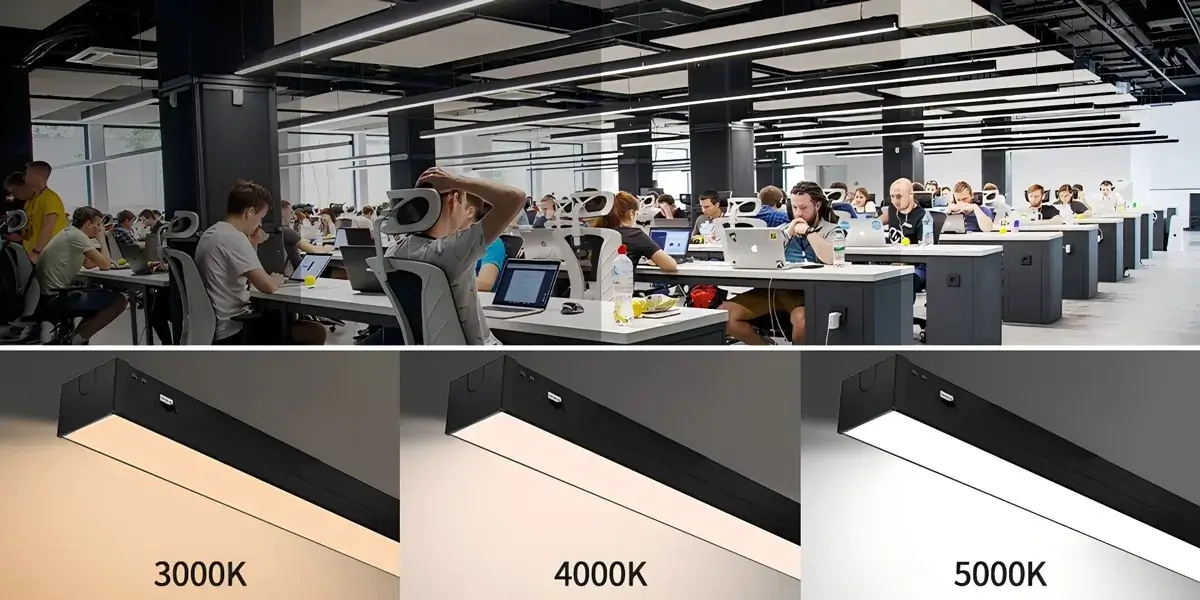
- Renk İşleme İndeksi (CRI): Ofis ortamlarında doğru renk üretimini sağlamak, görsel yorgunluğu azaltmak, belge okunabilirliğini artırmak ve ekran işbirliği verimliliğini artırmak için profesyonel çalışma ortamları için uluslararası aydınlatma standartlarını karşılarken RA ≥ 90 CRI önerilir.
- göze çarpan değer: Bir LED doğrusal ışık parlama değeri (UGR) <19, gözlere doğrudan ışığa maruz kalmanın neden olduğu parlamayı etkili bir şekilde bastırır, görsel yorgunluğu ve dikkatin dağılmasını önler. Bu standart, özellikle uzun süreli bilgisayar tabanlı ofis senaryoları için uygun olan çalışma yüzeyinde tek tip aydınlatma sağlayan CIE 117-1995 uluslararası aydınlatma standardına uygundur ve sağlıklı bir aydınlatma ortamının temel göstergelerinden biridir.
- Parlaklık: Ofis çalışma yüzeylerinde 300–500 lüks ve koridorlarda/koridorlarda ≥150 lüksü koruyun; karanlık alanlardaki gölgeleri etkili bir şekilde ortadan kaldırmak için doğrusal ışıklar ≤1,5 metre arasında tutun.
Farklı ortamlar için renk sıcaklığını seçme referansı
| alan | Tavsiye edilir Color TSICAKLIK | bilimsel Beş |
| sıradan ofis | 4000K | Odaklanma ve konforu dengeler, 8 saat boyunca sürekli çalışmayı destekler |
| Tasarım/Laboratuvar | 5000K | Renk oluşturma doğruluğunu artırır (Renk oluşturma indeksi RA≥90 gereklidir) |
| konferans salonu | 4000K | Dikkati dağıtan ve toplantı verimliliğini artıran yüksek renk sıcaklıklarını önler |
Bölgesel aydınlatma planı
- Açık ofis alanı: Tek bir ışık kaynağının neden olduğu dengesizliği önlemek için ana aydınlatma (70% parlaklık) ve yerel aydınlatma (30% parlaklık) kombinasyonu.
Ana aydınlatmanın, ışığın tüm alanı kaplamasını sağlamak için üstte eşit olarak dağıtılmış uzun basamaklı doğrusal ışık şeritleri ile manyetik izler ve doğrusal ışık dizileri ile eşleştirilmesi önerilir. Bu, esnek alan gereksinimlerini karşılamak için daha sonra ışık kaynağı konumunu tamamlamayı veya ayarlamayı kolaylaştırır.
Karanlık bölgeleri önlemek için ≤ 1,5 metre, ortalama aydınlatma 300–500 lükste korunur. Ek olarak, doğrudan ekran aydınlatmasını önlemek için 30° açılı aydınlatmayı desteklemek için ayrı iş istasyonlarına doğrusal ışıklar eklenir. Hassas yerel aydınlatma, iş verimliliğini artırarak gölge girişimini azaltır. Parlamanın görsel konforu etkilemesini önlemek için ekranlarda doğrudan ışıktan kaçınılır.
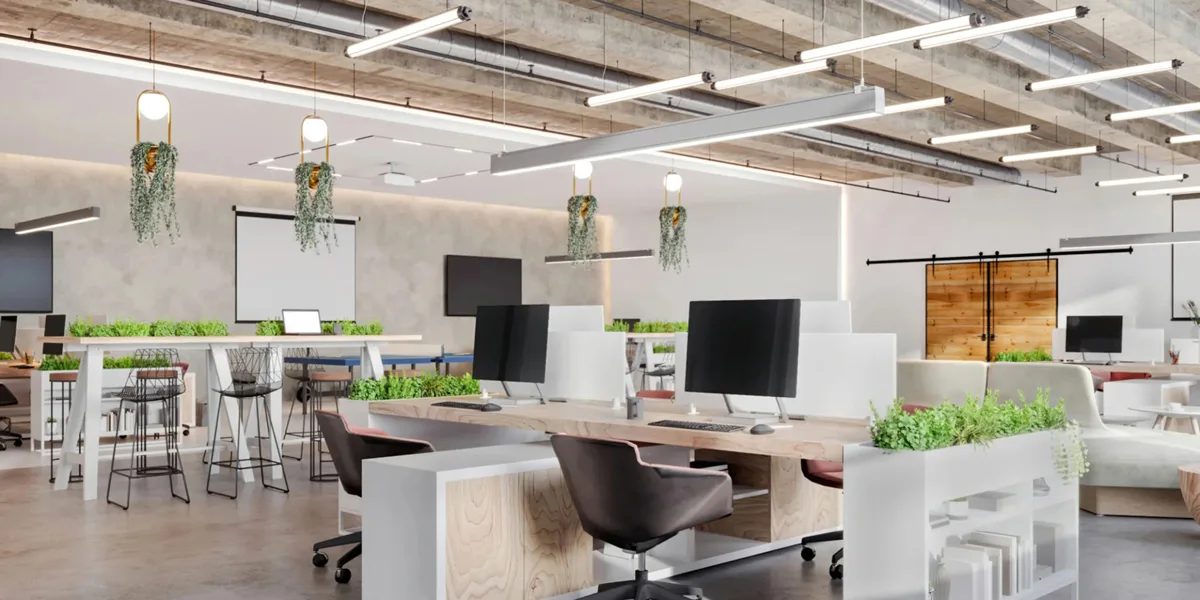
- Koridorlar ve geçitler: Parlamayı önlemek için yerden 30 cm yükseklikte L şeklindeki doğrusal ışıklar yerleştirin; Temizleme ve sulama senaryolarına dayanmak için IP54 veya daha yüksek bir su geçirmezlik derecesi seçin.
- Toplantı alanları ve dinlenme alanları: 300 lux'ta tek tip taban aydınlatması sağlamak için toplantı masalarının üzerine gömülü doğrusal ışıklar kullanın. Dinlenme alanlarında, rahatlatıcı bir atmosfer yaratmak için perde kutularında gizli ışık şeritleriyle eşleştirilen 2700K sıcak ışığa geçin. Dosya dolapları, doğrudan göze maruz kalmayı önlemek için duvarlara veya dolap içlerine yönelik ışıkla birlikte belge alımını kolaylaştıran gizli ışık şeridi tasarımlarına sahiptir.
Kurulum Gereksinimleri
- Hafif oluk ve ışık şeridi uyumluluğu: ≥12cm derin tavanlar için 2835 ışık şeridi (120 boncuk/metre) kullanın; sığ tavanlar için, grenliliği ortadan kaldırmak için COB ışık şeritleri (480 boncuk/metre) seçin. Alçıpan gömülü profiller için, sıvama sonrası pürüzsüz kenarlı ve çatlaksız 20 mm derinlik önerilir.
- Güç ve ısı dağılımı: 10 metreyi aşan ışık şeritleri için, uçlarda voltaj düşüşünü ve kararmayı önlemek için her iki uçta da çift uçlu bir güç kaynağı gereklidir. Alüminyum profil ışık yuvaları, ısı yayılım kanatçıklarıyla birleştirilir, ışık şeridi çalışma sıcaklığının ≤50°C kalmasını sağlar. Standartlaştırılmış konektörler: Satın alırken, modifikasyon israfını önlemek için üç pimli/iki pimli özelliklerle uyumluluğu onaylayın.
- Titreşim Gereksinimleri: Direnç-kapasitör voltaj azaltıcı güç kaynaklarından kaçının; titremesiz sürücü güç kaynaklarını önceliklendirin. Armatür ömrünü uzatmak ve görsel yorgunluğu önlemek için sabit akım sağlayın. Açıldıktan sonra, ışıkta titreme veya çizgileri kontrol etmek için bir akıllı telefon kamerası kullanın.
Akıllı kontrol genişletme
Akıllı LED sistemi, gruplandırılmış kararmayı kontrol etmek için DMX512 protokolünü kullanmak, toplantı ve fazla mesai modları arasında renk sıcaklığını değiştirmek, bir insan varlık sensörüne bağlı bir Wi-Fi Smart sistemi kullanmak, birisi çalışırken ışık parlaklığını artırmak ve hiç kimse yokken karartmak, enerji tasarrufu sağlayan hedeflere ulaşmak için otomatik olarak güç tüketimini azaltmak gibi renk sıcaklığını ve parlaklığını otomatik olarak ayarlar.
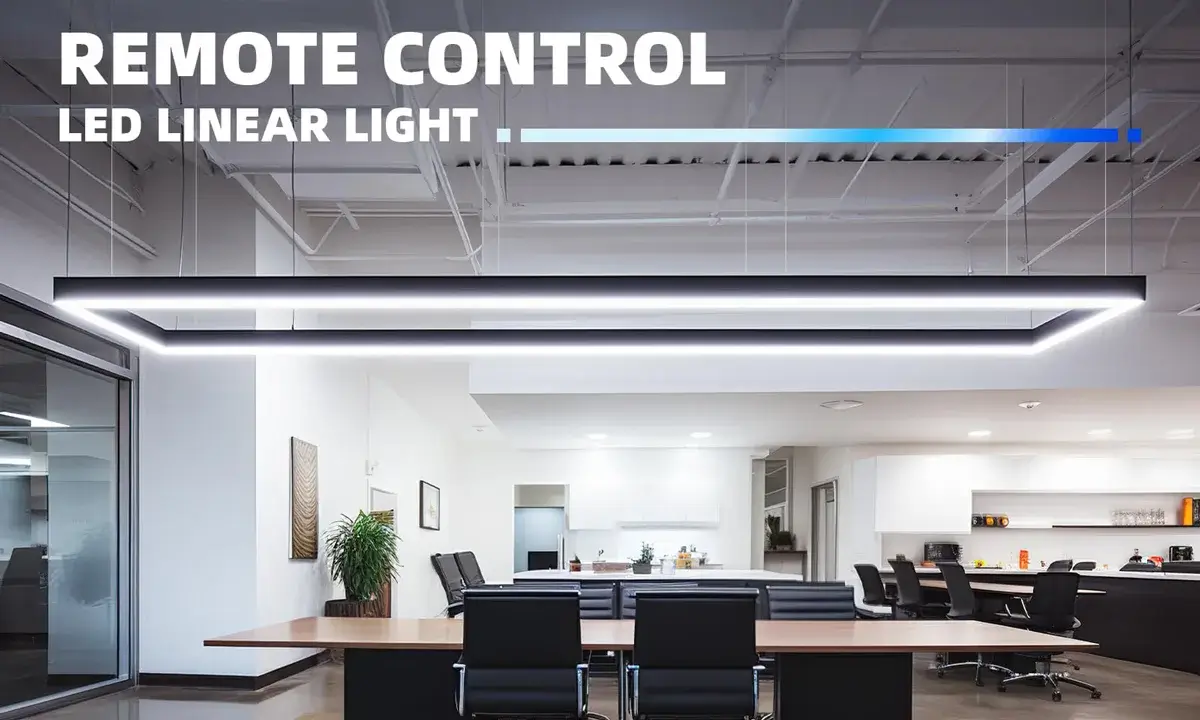
Kabul kriterleri
Herhangi bir iş istasyonunda görünür ışık lekesi yok; ışıklar kapatıldıktan sonra titreyen “hayalet” yok (nötr ve canlı kablo bağlantılarını kontrol edin), doğrudan 3 metre öteden ışık kaynağına bakıldığında parlama yok.
Kabul kriterleri
| Öğe | Kabul parametreleri | Test Araçları |
| kamaştırıcı kontrol | ugr19 | kamaştırıcı testere |
| Renk sıcaklığı tutarlılığı | Bitişik ışık şeritleri arasındaki renk sıcaklığı farkı ≤100K | Çok noktalı örneklemeli spektrometre |
| yanıt hızı | Sahne değiştirme gecikmesi ≤0,5 saniye | Kronometre Ölçümü |
LED doğrusal ışıklar takmak için notlar
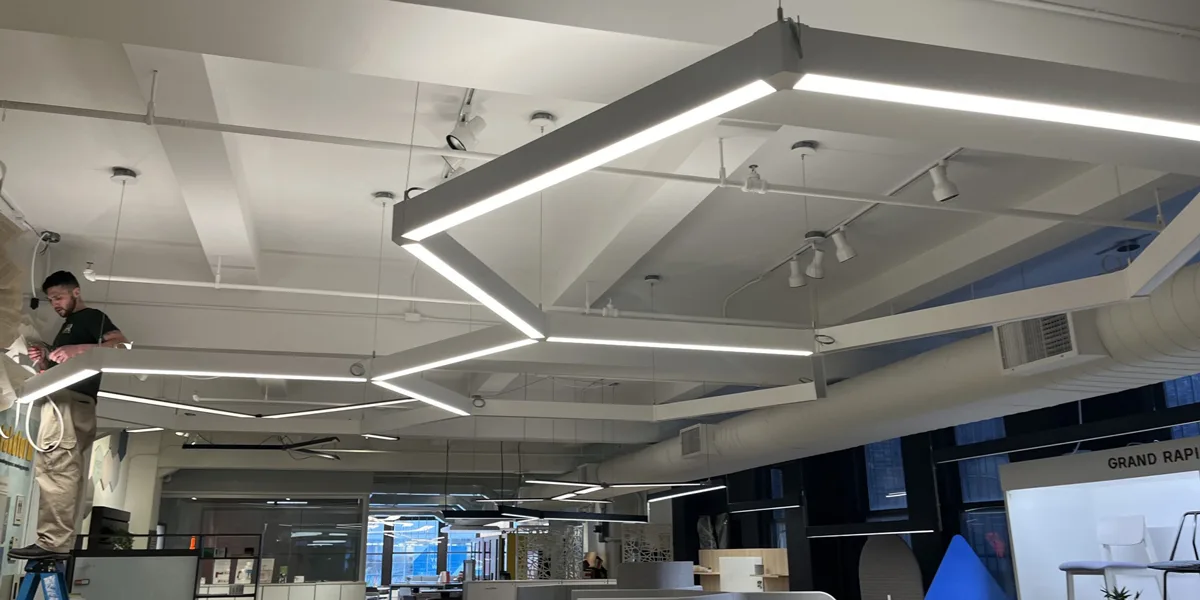
Kurulum Hazırlığı: LED doğrusal ışıkları takmadan önce, devreye güç kablolarının önceden takıldığından emin olun, kurulum yerinin kesin boyutlarını ölçün ve profiller, ışık şeritleri ve güç kaynakları gibi malzemeleri hazırlayın.
Işık şeritlerinin metre başına güç parametrelerini kontrol edin. Kurulum yerini bir seviye kullanarak işaretleyin ve profilleri vida veya yapısal yapıştırıcı ile sabitleyin. ≥12 mm derinliğe sahip dekoratif ışık kanalları için, 2835 ışık şeridi (metre başına 120 LED) veya sığ kanallar için, grenli bir görünümü önlemek için COB ışık şeritleri (metre başına 480 LED) kullanın. Alçıpan tavanlar için, sıvama sonrası pürüzsüz bir yüzey sağlamak için 20 mm kenarsız profiller kullanmanızı öneririz.
Güç kaynağı yapılandırması: LED boncuklara zarar verebilecek düşük kaliteli güç kaynaklarının neden olduğu dengesiz çalışmayı önlemek için markalı sürücü güç kaynaklarını kullanın. Güç kaynağını bakım erişim panellerinde, gömme ışık deliklerinde veya dolaplarda gizleyin ve bakım için yedek kablolar bırakın. Işık şeridinin metre başına güç parametrelerini kontrol edin, güç kaynağının gücünü kurulum uzunluğuna göre hesaplayın ve ışık şeridinin toplam gücünü güç kaynağının toplam gücünün 80% ile eşleştirin. Bu, güç kaynağının aşırı yüklenmemesini sağlar ve çalışma ışıklarının ömrünü uzatır.
Işık Şeridi Parametreleri: Işık şeritleri tipik olarak doğrusal ışıkların içine monte edilir. Işık şeridinin renk oluşturma indeksi (CRI) RA ≥ 90 olmalıdır ve renk sıcaklığı, alandaki diğer aydınlatma armatürleriyle tutarlı olmalıdır; örneğin, 4000K ofis alanında başka bir renk sıcaklığı bulunmamalıdır. Uzun mesafeli kurulumlar için, her iki uçta da tutarlı voltaj düşüşü sağlamak için güç kaynağına güç kaynağına her iki ucu da bağlanmalıdır, bu da aşırı kablo uzunluğunun LED çiplerinde karanlık bölgelere neden olmasını önler.
Ön kurulum ve sabitleme: Marangozluk aşamasında, daha sonra çatlamayı önlemek için ışık yuvalarını önceden takın ve yuvaların içine çatlama önleyici ağ uygulayın. Açık ışıkları takarken, alüminyum yuvalarını sabitlemek için klipsler kullanın ve ışık bozulmasını önlemek için ışık şeritlerini ortalayın.
Köşe Tedavisi: Profilleri 45° açıyla kesin ve birleştirin. Köşelerde delikler açın ve ışık şeritlerini kaynak yerine geçirin. Işık şeritlerini bükerken, boncukların patlamasına neden olabilecek 90° sert kıvrımlardan kaçınmak için bunları deliklere nazikçe yerleştirin.
Toz ve koruma: Işık şeritlerinin alçı kirliliğini önlemek için sıva uygulamadan önce ışık yuvalarına maskeleme bandı uygulayın; gölgesiz ışık çıkışı sağlamak için difüzörü takmadan önce enkazı temizleyin.
Açılış testi: Ters çevrilmiş nötr ve canlı kabloları önlemek için devreyi açmadan önce test edin. Anahtar canlı kabloyu kontrol etmelidir! Canlı kabloyu nötr kabloya yanlış bağlamak, ışıkları kapattıktan sonra titremeye ve "hayalet"e neden olabilir. Ters ve canlı kabloları önlemek için devreyi açmadan önce test edin.
Kesme Szerre: Işık şeridini işaretli konumlara göre kesin; yanlış hizalama tüm bölümün yanmamış kalmasına neden olur. Siyah kırılma riskini ortadan kaldırmak için derzleri lehimleme ile güçlendirin.
kabul etme: Titreme yok, granüler doku yok, karanlık bölge veya kırılma yok. Duvar Gereksinimleri: Sıvama işleminden sonra, ışık yuvalarının kenarları dalgalardan arındırılmış olmalı ve duvarın düzlüğü aydınlatma altında standartları karşılamalıdır.
LED Doğrusal Aydınlatma Maliyeti ve Yatırım Getirisi
LED doğrusal aydınlatma, önemli enerji tasarrufu ve hızlı yatırım getirisi sağlayan zorlayıcı bir maliyet-fayda analizi sunar. LED doğrusal aydınlatma çözümleri, küresel çekicilik ve kanıtlanmış sonuçlar sunan, verimlilikleri ve performansları nedeniyle küresel olarak tanınır ve benimsenir.
Aşağıdakiler, endüstri verileri ve pratik vaka çalışmalarını birleştiren LED doğrusal aydınlatma için maliyet yapısı ve yatırım getirisi analizinin bir dökümüdür:
- Temel malzeme maliyetleri:Işık kanalları ve ışık şeritleri: Temel modeller (plastik ışık kanalları ve Standart LED ışık şeritleri) transformatörler dahil olmak üzere metre başına yaklaşık 16 RMB'ye mal olmak; orta-yüksek uçlu modeller (alüminyum alaşımlı ışık kanalları ve koçanı ışık şeritleri) metre başına 150 ila 600 RMB arasında değişir.
- Akıllı Sistem Premium: Karartma/renk sıcaklığı işlevselliğine sahip akıllı doğrusal ışıklar, ek bir maliyete 40%-60% (metre başına 300-1000 RMB) ek bir maliyet getirir.
- Kurulum ve ek maliyetler: İşçilik maliyetleri: Karmaşık kablolama için (örneğin, tavan yuvası kesimi) metre başına 30-80 RMB'lik ek maliyetlerle, temel kurulum maliyetleri metre başına 20-50 RMB.
- Yüzeye monte çözüm: Slotsuz geçmeli kurulum, işçilik maliyetlerini 30% kadar azaltır ve 45° köşe tasarımı kablolama giderlerini daha da azaltır.
- Gizli maliyet riskleri: Hammadde dalgalanmaları: Bakır fiyatları 2025 yılında ton başına 80.000 yuan'ı aştı ve PCB kartı maliyetlerini 15%-20% ile artırdı.
- Tarife Etkisi: ABD'nin karşılıklı tarife politikaları, sürücü güç kaynaklarının fiyatını 3%-20% ile artırmasına neden oldu.
Hangi uygun maliyetli LED doğrusal ışık tedarikçileri tavsiye etmeye değer?
Bir LED doğrusal ışık tedarikçisi seçerken, saygın ve güvenilir bir tedarikçi ile çalıştığınızdan emin olmak çok önemlidir. Sektör performansı ve teknik avantajlara dayalı olarak, aşağıdaki markalar 2025 pazar testinde olağanüstü performans sergileyerek fiyat, performans ve dayanıklılığı dengeleyerek hem konut hem de ticari ortamlara uygun hale getirmiştir:
Toplu aydınlatma: Parlama önleyici petek tasarımı, RA95 kadar yüksek renk oluşturma indeksi (CRI), doğal ışıkla yaklaşıyor, uygulama tabanlı karartma, göz koruması için mavi ışıksız sertifika, kolay kurulum ve uygun fiyatlandırmayı destekliyor, akıllı ev ihtiyaçlarına uygun.
NVC Aydınlatma: Güçlü stabiliteye sahip 24V düşük voltajlı bir güç kaynağı sistemi, özel transformatörleri destekler ve 4000K sıcak beyaz ışık, akıllı alanda lider ve kullanıcılar tarafından maliyet etkinliği ile tanınan bir ev ortamı yaratır.
Foshan Aydınlatma (FSL): JD'de en yüksek satışa sahip köklü bir devlete ait kuruluş, düşük voltajlı ışık şeritleri, isteğe bağlı beyaz ışık/ılık ışık çift renk sıcaklıkları, bütçe dostu ve temel aydınlatma yenilemeleri için uygun olan 20 metreye kadar sabit bir güç kaynağını destekler.
Pak: Esnek kesim için CB ışık şeritleri kullanır, beyaz ışık efektleriyle uyumlu siyah ışık yuvaları, güçlü uyum ve mükemmel maliyet kontrolüne sahiptir ve yüksek renk üretimi gereksinimleri olan yerler için uygundur.
isıtıcı: Mi Home APP akıllı kontrol paketi, Bluetooth güç kaynağı ile eşleştirilmiş üç renkli CB ışık şeritleri, akıllı bağlantıyı takip eden kullanıcılar için uygun, grenli olmadan tek tip ışık çıkışına sahip olduğu test edildi.
aux: Yivlere ihtiyaç duymadan yüzeye monte tasarım, geçmeli sabitleme, kurulumu basitleştirir, yumuşak ve düzgün açık renk, tavanlara sorunsuz bir şekilde entegre olur ve kurulum maliyetlerini azaltır.
SignliteLED: Dış mekan ve ticari projeler için ideal, uzun ömür ve enerji tasarrufu sağlayan teknoloji ile ünlü evlerde ve otellerde ortam yaratmak için uygun dekoratif ve fonksiyonel unsurları birleştiren yenilikçi tasarım.
LED doğrusal ışıkları seçmek için önemli hususlar
Hafif Şerit Tipi : Sainai Optoelectronics'in COB ışık şeritlerine metre başına 480 LED veya metre başına 528 LED (granlılık olmadan tek tip ışık çıkışı) öncelik verin. Bunlar, patlamaya dayanıklı boncuklu geleneksel LED ışık şeritlerine uygun maliyetli alternatiflerdir ve 5 santimetrelik kesimlerle esnek uzunluk ayarlarını destekler.
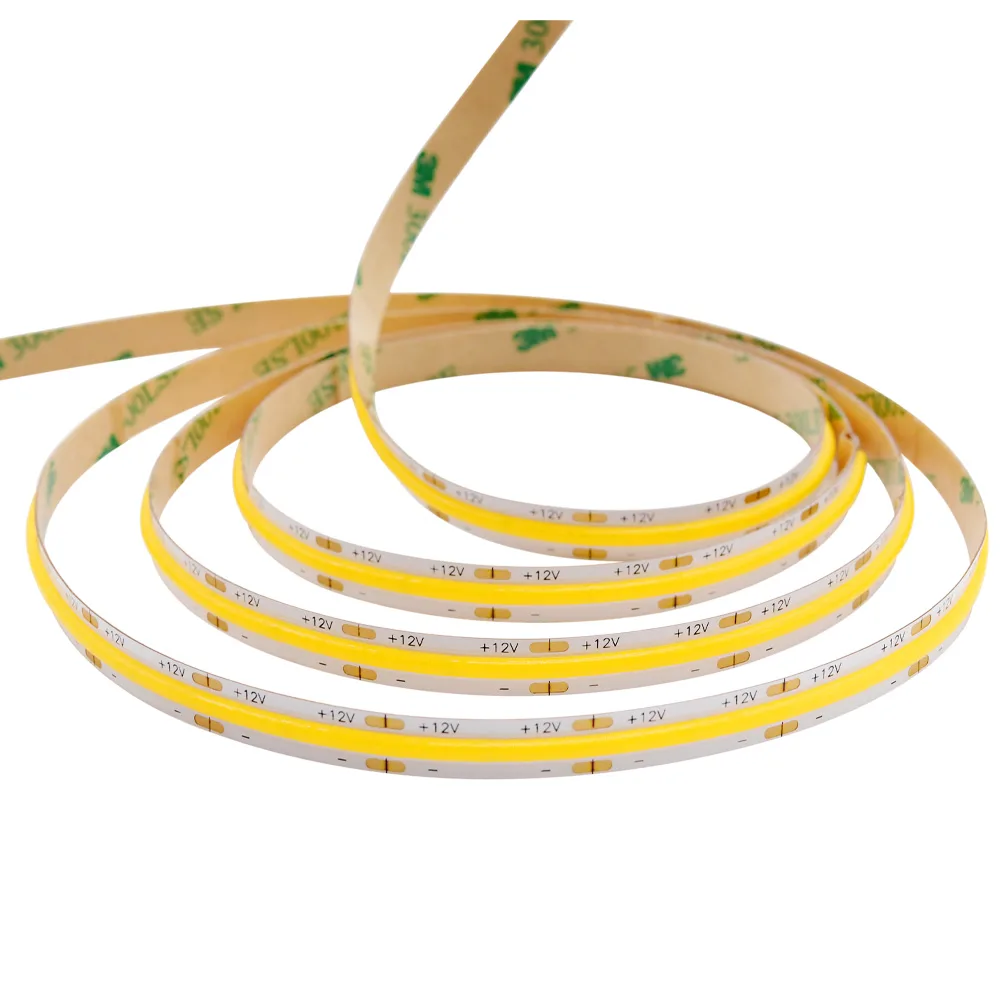
Tek Renkli COB LED Şerit Işık
Ana Model: FYX08T480C
Metre Başına LED Çip Miktarı: 320/384/480/528chips (Sanan)
CRI: >90
PCB Genişliği: 8mm/10mm
Renk Sıcaklığı: 2700K/3000K/4000K/6500K
Giriş Voltajı: DC12V/DC24V
Metre Başına Güç: 8W/10W/11W/14W
Verimlilik: 130-150LM / W
IP Sınıfı: IP20/IP54/IP65/IP67/IP68
Garanti: 3 yıl
Güç ve parlaklık: Metre başına 11-14 watt'lık bir güç derecesi seçin. 3000K renk sıcaklığı atmosferik bir ortam yaratır, 4000K ise ofis aydınlatması için uygundur.
Isı dağılımı ve malzeme: Alüminyum ışık kanalları Plastik ile karşılaştırıldığında üstün ısı dağılımı sağlar. Parlamayı azaltmak için siyah bir kapakla eşleştirin ve RA ≥ 95 renk oluşturma indeksi (CRI) ile görsel rahatlık sağlayın.
Maliyet kontrolü: Birim fiyatı yaklaşık 12-16 yuan/metredir (ışık kanalı ve ışık şeridi dahil). 10 metreyi aşan uzunluklar için, ışık bozulmasını önlemek için ek bir güç kaynağı gereklidir. Aşamalı yenileme, ilk yatırımı azaltır.
Göz kamaştırma sorunları: Küçük boyutlu doğrusal ışıklar, düşük ışıklı ortamlarda parlamaya neden olabilir. Işık kaynağına doğrudan maruz kalmamak için gömme kurulum veya ışık kalkanının kullanılmasını öneririz.
eskime Rdere: Çok renkli karartma gibi bazı tasarımlar, düşük pratiklik ile kısa ömürlü trendler olabilir. Klasik, minimalist stillere öncelik verin.
Bakım COST'ler: Akıllı sistemler IoT protokolleriyle uyumlu olmalıdır. kâğı -Monte edilmiş sistemler daha pahalıdır ancak daha düşük bakım sıklığı gerektirir. Uygun marka ve kurulum çözümleri seçmek, estetik ve işlevselliği dengelerken 2-3 yıl içinde yatırımları telafi edebilir.
Renk İşleme İndeksi (CRI): Nesnelerin gerçek renklerini doğru bir şekilde yeniden oluşturmak için RA ≥ 95'i seçin (gerçek ölçülen değer ≥ 90 olmalıdır).
Renk sıcaklığı eşleşmesi: Ofis alanları için 4000K nötr ışık ve dinlenme alanları için 2700K sıcak ışık seçin.
Özet
Signliteled 2013 yılında kurulmuştur ve lider bir üreticidir. LED lineer aydınlatma sektördeki sistemler. Profesyonel bir Ar-Ge tasarım ekibimiz ve aydınlatma test ekipmanlarımız var. LED doğrusal aydınlatma sistemleri üretiminde kapsamlı deneyime sahip, küresel müşterilere doğrusal aydınlatma sistemleri için yaratıcı özelleştirme hizmetleri sunuyoruz. Vizyonunuzu bize bildirin ve en iyi LED lineer aydınlatma üreticilerinden ve tedarikçilerinden biri olarak profesyonel ekibimiz vizyonunuzu hayata geçirecektir. En son teklifler ve danışmalar için lütfen bizimle iletişime geçin, size en kısa sürede yanıt vereceğiz.
